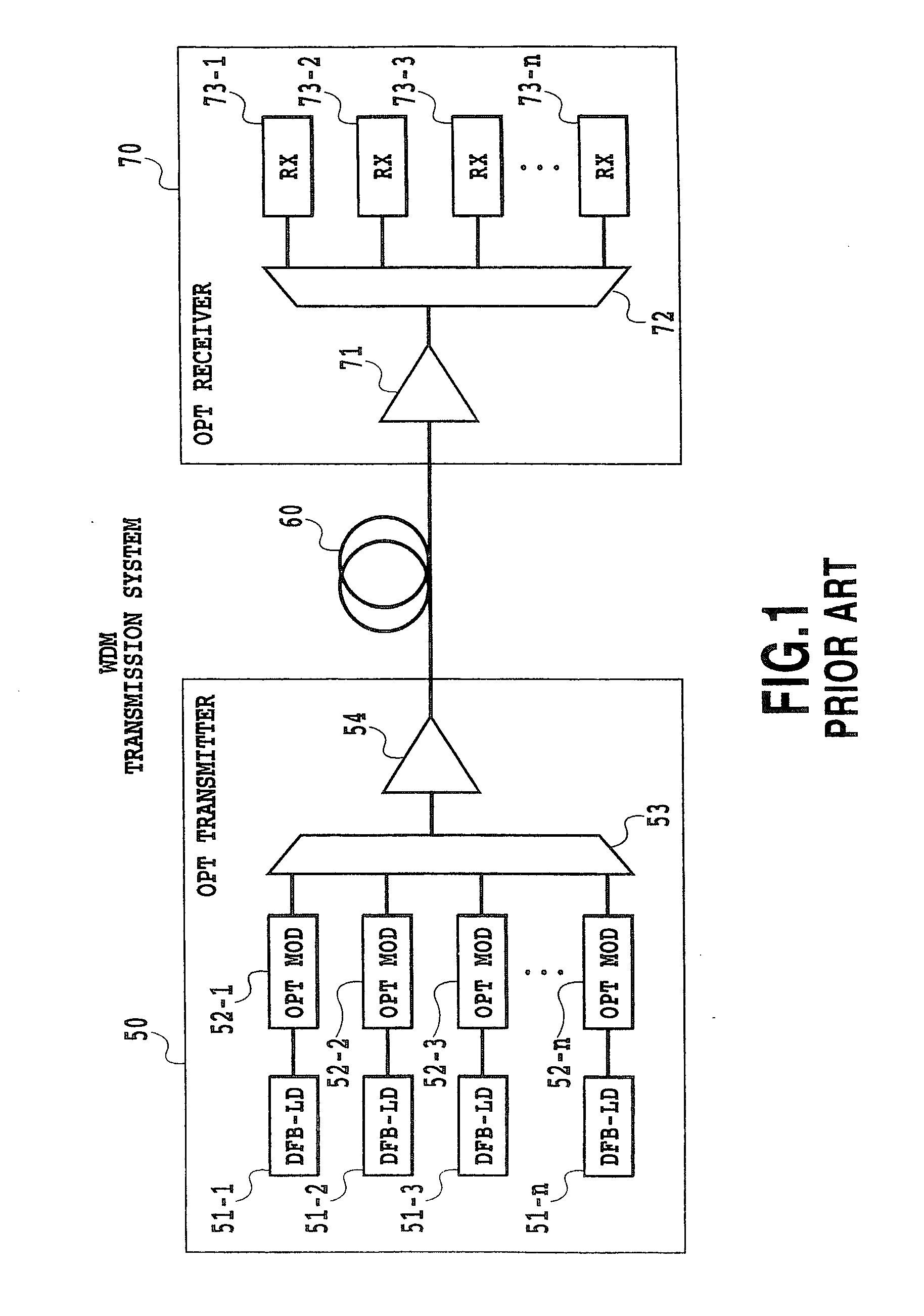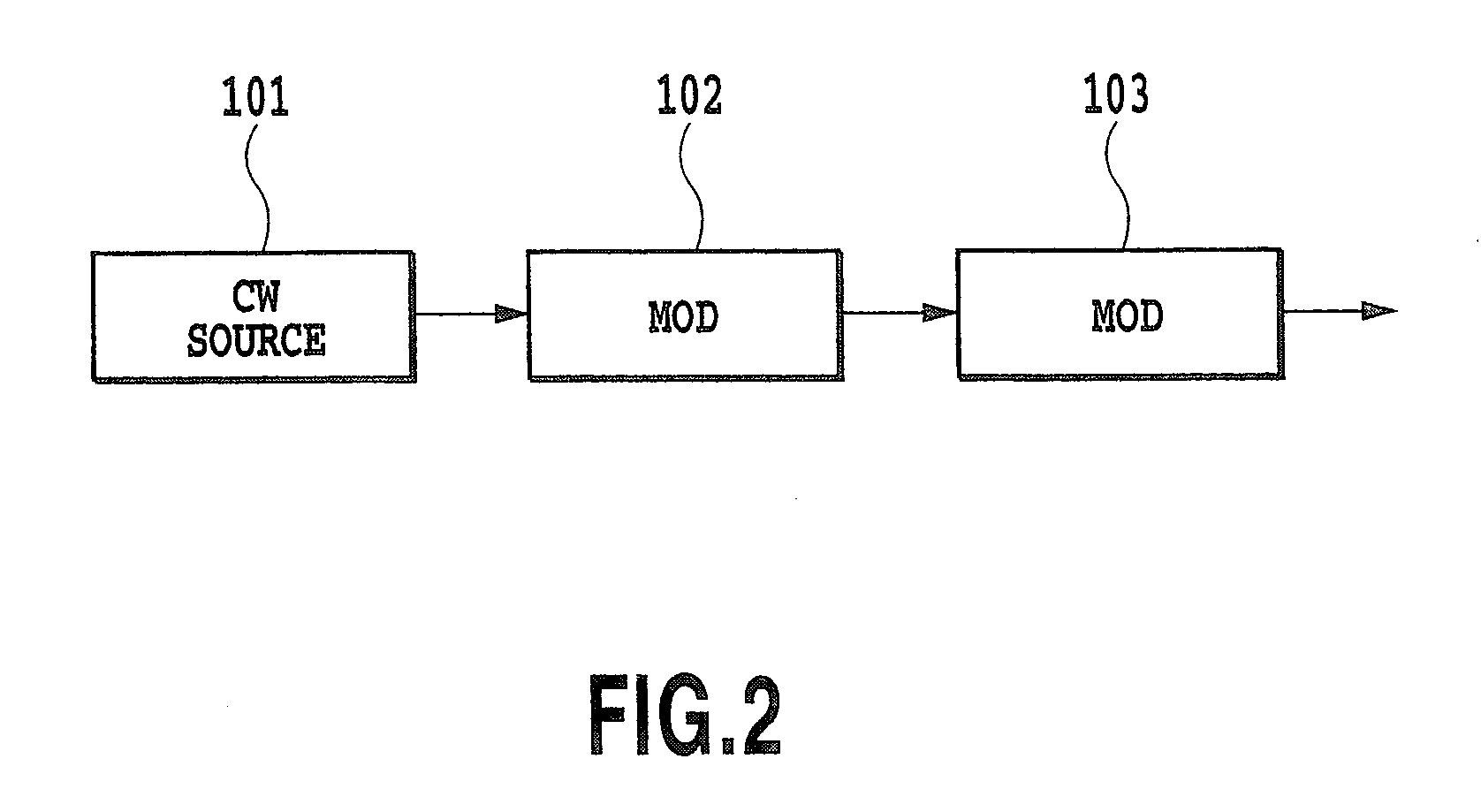Multi-wavelength generating method and apparatus based on flattening of optical spectrum
a multi-wavelength and optical spectrum technology, applied in multiplex communication, instruments, optical elements, etc., can solve the problems of inability to dynamically control the deviation of power level among longitudinal modes, incoherent and thus unsuitable for dense wdm transmissions involving a large number of wavelengths, and ineffective design and production
- Summary
- Abstract
- Description
- Claims
- Application Information
AI Technical Summary
Benefits of technology
Problems solved by technology
Method used
Image
Examples
eleventh embodiment
[0273] As described above, this embodiment provides the configuration comprising the modulating section having the at least one optical modulating means coupled together in series and arranged at the predetermined locations of the plurality of paths including the one to which the incident light of the single central wavelength is input, and the plurality of voltage applying means for independently regulating and applying the signal voltage of the predetermined period to the input port of the optical modulating means. In this configuration, a multi-wavelength light is generated by flattening the incident light depending on the regulated and applied signal voltage and the predetermined period of the signal voltage, thus making it possible to generate a WDM signal as a multi-wavelength light having a flattened optical spectrum, using the simple and inexpensive configuration and without the need to design a complicated optical circuit. [Application of the Multi-Wavelength Generating App...
second embodiment
[0281] (Second Embodiment of the Coherent Multi-Wavelength Signal Generating Apparatus)
[0282] FIG. 51 shows the second embodiment of the coherent multi-wavelength signal generating apparatus. The coherent multi-wavelength signal generating apparatus of this embodiment includes an optical amplifier 320 for amplifying a multi-wavelength light which amplifier is arranged between the multi-wavelength light source 311 and demultiplexer 312 of the configuration of the first embodiment so that part of the amplified multi-wavelength light is guided to the control circuit 350.
[0283] FIG. 52 is an example of the configuration of a WDM transmission system using the coherent multi-wavelength signal generating apparatus of the present invention. In FIG. 52, an optical receiving section 370 connected to a coherent multi-wavelength signal generating apparatus 10 via an optical amplifier 371 for amplifying a transmitted WDM (Wavelength Division Multiplexing) signal light, a demultiplexer 372 for de...
example 2
[0309] (Example 2 of Design of the Signal-to-Noise Ratio SNR for Outputs from the Modulator)
[0310] In the coherent multi-wavelength signal generating apparatus shown in FIG. 50 or 51, the band of a receiver 373 of the WDM transmission system shown in FIG. 52 is defined as Be[Hz], the demultiplexing band of the demultiplexer 372 is defined as B.sub.0[Hz], the signal mark rate is defined as M, the signal light intensity of an output from the i-th modulator is defined as P(i)[dBm], the intensity of the stimulated emission light in the output from this modulator is defined as Pc(i)[dBm], the intensity of the spontaneous emission light in the output from this modulator is defined as Ps(i)[dBm], an equivalent current flowing through the receiver is defined as Ieq[A], the rate of leakage from the j-th port to the i-th port of the multiplexer is defined as XT(j), the light intensity of a cross talk signal from the multiplexer is defined as Px(i)[dBm], shot noise in the signal components is ...
PUM
| Property | Measurement | Unit |
|---|---|---|
| width | aaaaa | aaaaa |
| frequency | aaaaa | aaaaa |
| repetition frequency | aaaaa | aaaaa |
Abstract
Description
Claims
Application Information
 Login to View More
Login to View More - R&D
- Intellectual Property
- Life Sciences
- Materials
- Tech Scout
- Unparalleled Data Quality
- Higher Quality Content
- 60% Fewer Hallucinations
Browse by: Latest US Patents, China's latest patents, Technical Efficacy Thesaurus, Application Domain, Technology Topic, Popular Technical Reports.
© 2025 PatSnap. All rights reserved.Legal|Privacy policy|Modern Slavery Act Transparency Statement|Sitemap|About US| Contact US: help@patsnap.com



